#Roman Emperor Antoninus Pius
Photo


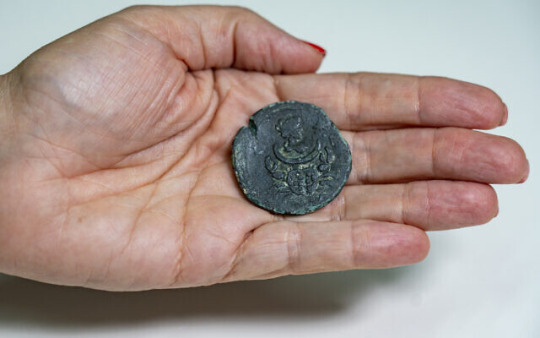
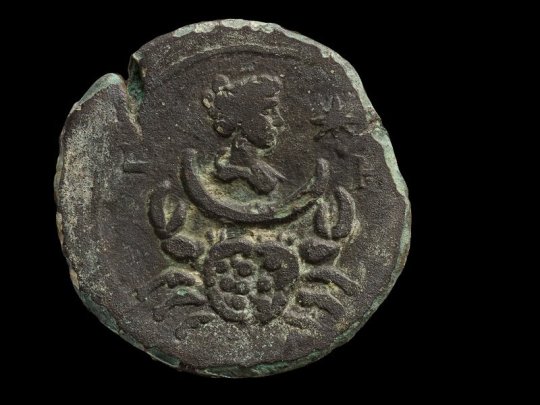
1,850-Year-Old Bronze Roman Coin Discovered on Israeli Beach
The coin was minted in Alexandria, Egypt, in the reign of Emperor Antoninus Pius and contains the image of the Cancer zodiac sign and the moon goddess Luna.
A bronze Roman coin dating back 1,850 years with the symbol of the Cancer zodiac sign and a moon goddess was just discovered in the Carmel Beach in Haifa by archaeologists from the Israel Antiquities Authority (IAA).
The coin was specifically discovered as part of a survey of the area in an effort to find antiques and save them from degradation.
This isn't the oldest Roman-era coin discovered - in fact, coins from the earlier Bar Kokhba revolt were found in Jerusalem two years ago. However, this coin was found in the water, is in remarkably good condition and its engravings shed considerable light on its origins and what it is meant to depict.
Israel in the Roman era
The coins used as money by the Romans were minted from gold, silver, bronze, copper and orichalcum - though historians are unclear as to what exactly the latter one is.
Over time, especially in the closing days of the Roman Republic and throughout the Roman Empire, these coins also contained a number of icons and writings.
This coin in particular is no exception, and the writing on it tells us exactly when the coin was minted, in year eight of the reign of Antoninus Pius, and where it was minted, Alexandria in Egypt.
Antoninus Pius was Roman emperor from 138 CE to 161 CE, so this would have been minted in either 144 CE or 145 CE.
Pius's reign was well remembered and historians note him as one of the Five Good Emperors - alongside Nerva, Trajan, Hadrian and Marcus Aurelius - that presided over Rome's great golden age of Pax Romana. This is despite the fact that Pius wasn't a military man like many other notable Roman emperors and in fact his long reign was largely peaceful. Rather, his great strengths were in his skilled administration of the large empire, a profitable economy with a massive surplus in the empire's coffers and for his work as a progressive legal reformer.
In fact, the administrative role Pius held was of such paramount importance to his reign that many historians believe he never actually left the city of Rome.
Pius's reign also saw him rule over what is now the State of Israel, with the Bar Kokhba revolt having ended just two years prior to his reign. This was important as it was now up to him to improve relations between the empire and the Jews, following the revolt and the many decrees of his predecessor, Hadrian, that had been extremely unpopular among the Jews, such as the ban on circumcision.
Pius was able to do this, however, and ties between Rome and the Jews improved. In fact, the Talmud even notes the close friendship between Antoninus Pius and the leader of the Jews in the Levant, Rabbi Yehuda Hanasi. Having said that, this is something some historians debate, as the Talmud just refers to an emperor known as Antoninus which could refer to either Pius's successor Marcus Aurelius, whose full name was Marcus Aurelius Antoninus, or Caracalla, whose full name was also Marcus Aurelius Antoninus, though his birth name was Luciuus Septimius Bassianus.
His image has been found on coins in Israel before, too. One such coin from this era was found in 2021. It, too, contains the image of Antoninus Pius, with the other side containing the image of the Syrian moon god Men and the inscription "of the people of Geva Phillipi" and the date of the civic year 217, which would be 158 CE or 159 CE.
What was on the coin?
In addition to explaining when and where it was minted, the coin also included symbols.
On one side was the image of Antoninus Pius himself along with the inscription.
The other side contained two symbols. One of them was a crab, the zodiac sign of Cancer. The other side was the moon goddess, Luna.
The inclusion of Cancer seemed to have been due to the coin being part of a series of coins with zodiac symbols.
Luna, however, is another story - but far from unprecedented.
Iconography in Roman coins tended to depict emperors and images of gods. This served to both spread the image and name of the emperor to the wider empire and associate him with a divine figure.
Luna was also important to the Roman Empire for another reason, as it was this goddess, along with the sun god Sol, that was used by the empire to represent Roman rule over the world as well as a guarantee of peace.
Its presence in the Carmel Beach
As Israel has been a pillar of the ancient world and has been ruled by numerous kingdoms and empires throughout history, it is no surprise that it is host to a wide range of archaeological finds, some of which are incredibly ancient.
However, as noted by IAA maritime archaeology unit director Yaakov Shavit, this is the first time something like this was found in Israeli waters.
"Along the shores of the Mediterranean Sea in the State of Israel and its maritime area, there are many archaeological sites and finds that tell of connections that exited here in ancient times between the ports of the Mediterranean and the many countries along its shores," Shavit said in a statement.
"These findings, which sunk into the abyss and disappeared from sight for hundreds and thousands of years, were preserved in an amazing way... and their discovery completes pieces of the historical puzzle of Israel's history."
Indeed, the discovery of this coin also reflects ever-changing perception of the sea in Israel and the vast importance it serves.
"In the last decade, Israel has been changing its perception of the sea," IAA director Eli Escozido explained. "Now, it is already clear that the sea is not the border of Israel, but is a significant part of it, in security, strategy and economics - and also in is heritage. It's home to natural treasures and cultural assets that must be explored and protected."
The finding of this coin, Escozido explained, is a "spectacular reminder" of the maritime archaeological survey.
Indeed, as the sea and its many aspects and resources, from security to natural gas and trade, become more important to Israel, it is worth remembering the host of ancient treasures and historic relics that could be lurking within its watery depths.
By Aaron Reich.
#1850-Year-Old Bronze Roman Coin Discovered on Israeli Beach#archeology#archeolgst#coins#collectable coins#ancient coins#roman coins#ancient artifacts#history#history news#ancient culture#ancient civilizations#roman empire#roman history#roman emperor antoninus pius
24 notes
·
View notes
Text
Roman Theater, Souks, Eid al-Fitr Amman Jordan

View On WordPress
#Amman Citadel#Amman Farmers Market#Bedouin Craftsman#Bedouin Tents#Egyptian Pharaoh Cleopatra VII of the Ptolemaic Dynasty#Eid al-Fitr Festival of Breaking the Fast#I&039;tikaf#Jabal Al-Jofah#Jordan Folklore Museum#Jordanian Museum of Popular Traditions#Nour al Barakah#Philadelphia Capital of the Roman Empire#Ptolemy Philadelphus#Ramadan#Roman Amphitheater Amman#Roman Emperor Antoninus Pius#Roman Triumvir Mark Antony#Souk el-Khodra#Souk el-Sagha#Souk Jara#Souk Mango
0 notes
Text
watching some lecture about the decline and fall of the roman empire (as in, the work of history by edward gibbon, not just the historical topic) and gibbon just got quoted as calling claudius "feeble". when it comes to the roman empire, my memory is a total sieve, and the only thing that I can ever remember is my middle-school happiness while reading i, claudius by robert graves so i have to be like wtf gibbon don't say that about my blorbo
#and then i read claudius the god in high school and didnt like it as much so maybe claudius isnt my blorbo after all#livia girlbossed too hard and tiberius was too pathetic and then too disgusting soon afterward...#theonly other roman emperor i can recall is antoninus pius for sending diplomats to china.#alternate history wherein imperial rome and imperial china were actively in contact ... imagine that slay ...
5 notes
·
View notes
Text

Aureus of Emperor Antoninus Pius, Roman, circa 147-148 AD
from The Yale University Art Gallery
282 notes
·
View notes
Text

Emperor Antoninus Pius (Roman 86-161 CE) National Roman Museum of Palazzo Massimo, Rome
295 notes
·
View notes
Text
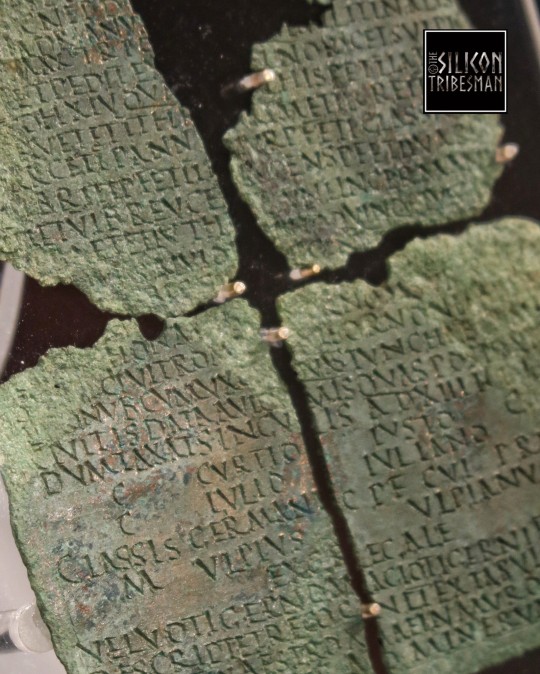
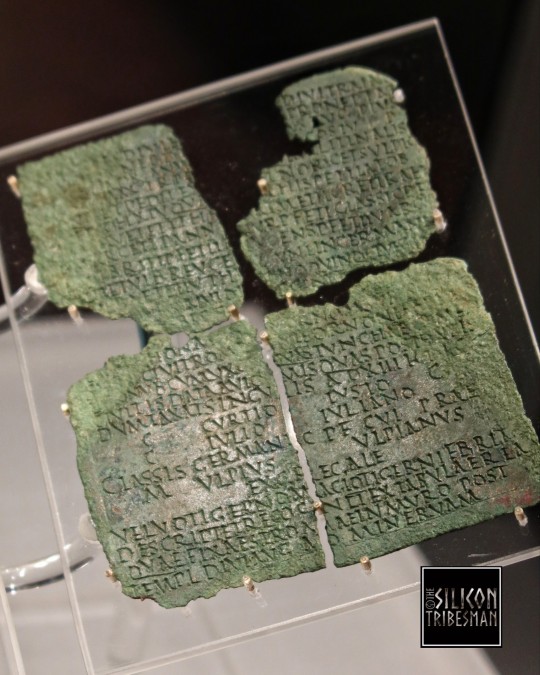

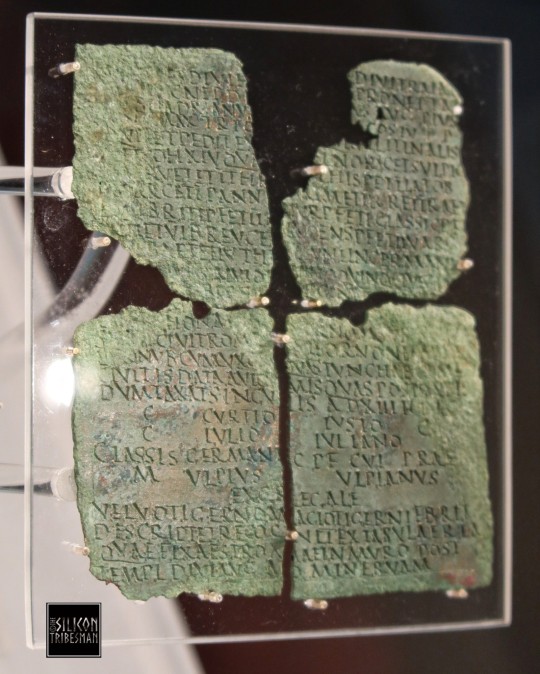
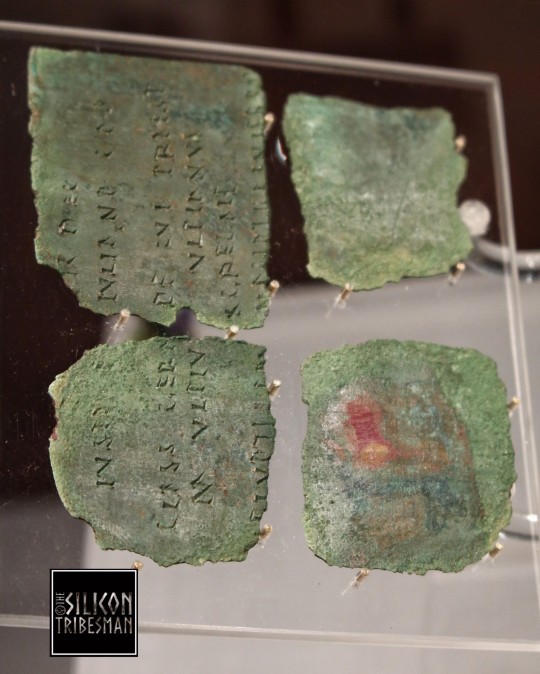
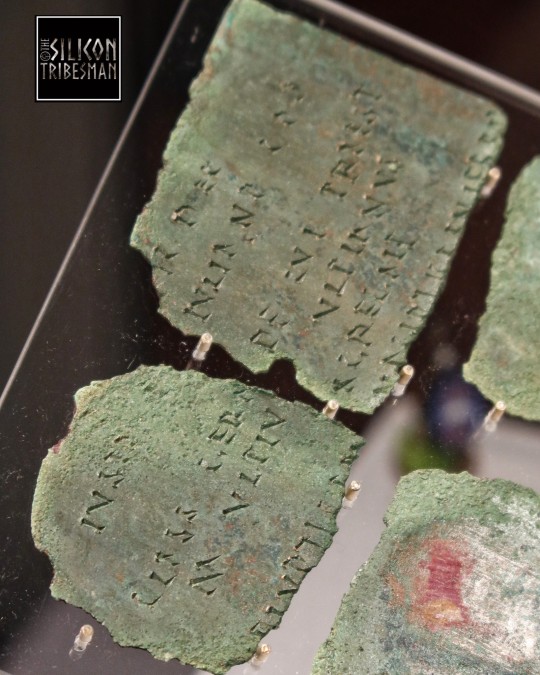
The Lanchester Roman Diploma
Found by a metal detectorist near Lanchester, Co. Durham, this is the first complete Roman Fleet Diploma to be discovered in the country and reveals the identity of one of Britain's first named sailors.
In the Roman Empire, there were citizens and non-citizens. Being a citizen gave you social and legal advantages. These included the right to own property, not pay some taxes and the right to have a lawful marriage. Most people in Britain at this time were not citizens. One way to become a citizen was to serve in the Roman army for 25 years, or the navy for 26 years. A diploma was the document that proved you had completed military service and could call yourself a Roman citizen.
The Lanchester Diploma was issued by the emperor Antoninus Pius (138-161 CE) to Veluotigernus, a Briton from Lanchester, County Durham, in around 150 CE. To earn his diploma, Veluotigernus had served in Classis Germanica, the Roman navy in Germany. We know his unit was based around Cologne, and that their main duties at this time were patrolling and logistics rather than combat.
It is unusual to be able to identify a local person from this period by name. Veluotigernus' British name ended with '-tigernus', which means 'king or 'master' This suggests that Veluotigernus was from a high-status local family. When he was honourably discharged from the navy, his name, according to the diploma became Titus Aelius Veluotigernus - illustrating that he, like many others, had embraced Roman culture. He is the second oldest known sailor in the country, and one of the few Britons we know to have served in the German fleet.
The diploma is made of a copper alloy. It consisted of two inscribed rectangular bronze plates,like pages in a book. The inside pages contained the complete text, whilst the outside had a shortened version, along with a list of seven witnesses. Each diploma was checked and then sealed to create a single document. It is very unusual to find a complete diploma.
Most diplomas were broken up, and the pieces passed to the recipient's children, allowing each of them to claim Roman citizenship. It is unclear what prompted Veluotigernus to bury the diploma rather than distributing the pieces amongst his close family.
The Museum of Archaeology, Durham University
#roman#diploma#roman fleet#sailor#lanchester diploma#archaeology#relic#artefact#text#metalwork#service#roman army#roman sailor#roman empire#romans
198 notes
·
View notes
Text
Wikipedia article that is only available in Spanish. I translated into English some abstract to share here. I always wanted to write a post about that "Antonine dynasty" fallacy. Luckily I found someone who explains much better

Ulpia-Aelia Dynasty
Ulpia-Aelia Dynasty is the new name proposed by Alicia M. Canto and adopted by a sector of current historiography to refer to the seven emperors of the Roman Empire, from Nerva to Comodo. Specifically includes emperors Trajan, Hadrian, Antoninus Pius, Marcus Aurelius and his co-emperor Lucius Verus.
Doctrinal approaches
Unlike other dynasties such as the Julio-Claudian dynasty, the Flavian dynasty or the Severan dynasty, there is no agreement in Ancient History on how to group and name the emperors of the 2nd century, "the best century in the history of Humanity" according the British historian Edward Gibbon.
The most used definitions from the 18th century until today have been and are "the Antonines", "the Good Emperors" and "the Adoptive Emperors". There were only two Antonine: Marcus Aurelius and Lucius Verus, and both were, above all, two Aelii (from the Aelia family). The adoptions were just a political cosmetic operation, but they did not comply with the ideal principles of adoption described by Galba or Pliny the Younger.
The inappropriateness of these three universal classifications is more evident in the face of the 48 ancient texts that demonstrate that throughout that century there existed an authentic dynasty, of Hispanic origins and roots, whose real link was not the adoptions, but the line of blood and kinship, entrusted to the women of the dynasty, who transmitted the legitimacy to inherit the throne: Pompeia Plotina, Vibia Sabina, Matidia the Younger, and both Annias, the so-called Faustina the Elder and Faustina the Younger, ending in Commodus.
After the elderly Nerva as a necessary introducer, the following six emperors: Trajan, Hadrian, Antoninus Pius, Marcus Aurelius, Lucius Verus and Commodus - externi (foreigners) according to the Roman historian Aurelius Victor - form an authentic lineage.
All this led Maria M. Canto to propose the term "Ulpio-Aelia", "the Ulpii Aelii", to define the true dynasty of Hispanic origin that goes from Trajan to Commodus (98-192 AD). Some ancient authors, such greek historian Herodian, demonstrate that the Romans themselves did see Commodus as a direct descendant of Trajan, katá thêlugonía ("by the maternal line"), that is, through the aforementioned empresses, and as "A fourth generation emperor".
The reason why names such as "the Antonine dynasty" or "the Antonine emperors" have universally triumphed is not found in ancient texts, but in the European historiography of the 17th and 18th centuries, whose arguments in this sense, although they do not find real foundation in the texts, have been so generally accepted until now.
The new proposal has already been accepted by authors such as José María Blázquez, the Italian expert Anna Maria Reggiani, among others, and the definition can be seen integrated even in some university subject programs. Although, without a doubt, two and a half centuries of historiographic tradition is still very decisive in favor of the other definitions in use.
Alicia María Canto y de Gregorio (Havana, April 23, 1949 – Madrid, March 4, 2024), known as Alicia M. Canto, was a Spanish archaeologist and epigrapher. In 2011 she was appointed corresponding academic of the Royal Academy of History.
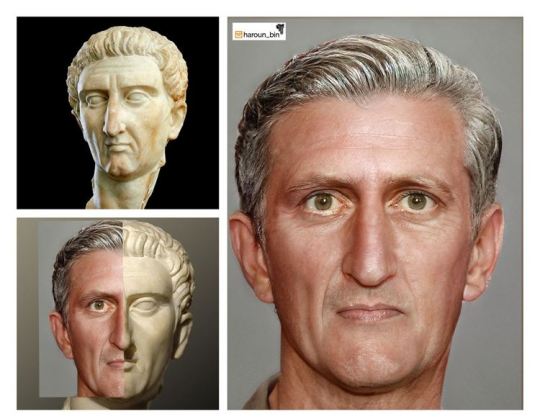
Nerva was chosen just as transitional ruler following the assassination of Emperor Domitian. Except him, the successors of "his dynasty" were related.
I'm really sick of hearing things such "Marcus Aurelius broke tradition by choosing moron Commodus just because he was his son; He made a serious mistake".
None of those emperors were chosen after going through a casting. Trajan's adoptive successor was his nephew, the only male relative he had, plus was married to Trajan's great-niece. Hadrian would have been emperor if Trajan had had a son? Marcus Aurelius and his wife Faustina were descendants of Trajan, he on his father's side and she on his mother's side. Marcus Aurelius did nothing more than continue the true tradition of his family.
Just as Augustus' dynasty is known as the Julio-Claudian, ending with Nero, Trajan's is the Ulpia-Aelia dynasty and ending with Commodus. And in my opinion the term Nerva Antonine dynasty, which I find in all English articles, simply doesn't make sense.
86 notes
·
View notes
Text

The Temple of Hadrian (Templum Divus Hadrianus, also Hadrianeum) is an ancient Roman structure on the Campus Martius in Rome, Italy, dedicated to the deified emperor Hadrian by his adoptive son and successor Antoninus Pius in 145 CE. This temple was previously known as the Basilica of Neptune but has since been properly attributed as the Temple of Hadrian completed under Antoninus Pius. x
240 notes
·
View notes
Text
A Thing Of Vikings Chapter 156: Journey To The West

Chapter 156: Journey to the West
Contrary to popular belief, Imperial Zhōngguó did have significant institutional and historical awareness of European states and societies prior to the diplomatic missions of Fa Mulan in AD 1043 and the opening of formal mutual diplomatic, economic, and academic ties to the west. In particular, they were aware of Imperial Rome, which they referred to as Daqin, although their detailed knowledge was mostly restricted to Rome’s eastern provinces in Syria and the Levant, with the oldest records dating back to more than a thousand years before Fa Mulan’s expedition.
Still, formal direct contact was rare, and information was normally passed through the intermediaries on the Silk Road. Typically, embassies went from west to east, such as the first formal contact in AD 166, featuring envoys dispatched in AD 161 by either Emperor Antoninus Pius or Marcus Aurelius Antoninus and meeting Emperor Huan of the Han Dynasty. Later contacts with Fulin, the new name used to refer to the Byzantine Empire in contrast with the older Imperial Roman Empire, were mostly with merchants and craftsmen and the occasional groups of monks (some of whom stole silkworms that were smuggled back to the Byzantines), although there were some formal diplomatic contacts recorded. There is dispute, however, whether these were envoys from the Byzantine Emperor and his central government, or from the famously fractious peripheral governors.
—Constantinople: The Child Of Rome’s Empire, Venice, Italy, 1795
AO3 Chapter Link
~~~
My Original Fiction | Original Fiction Patreon
26 notes
·
View notes
Photo
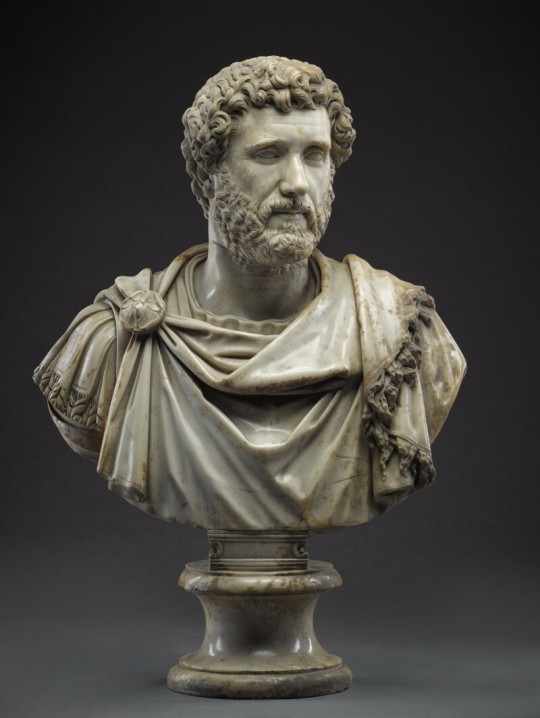
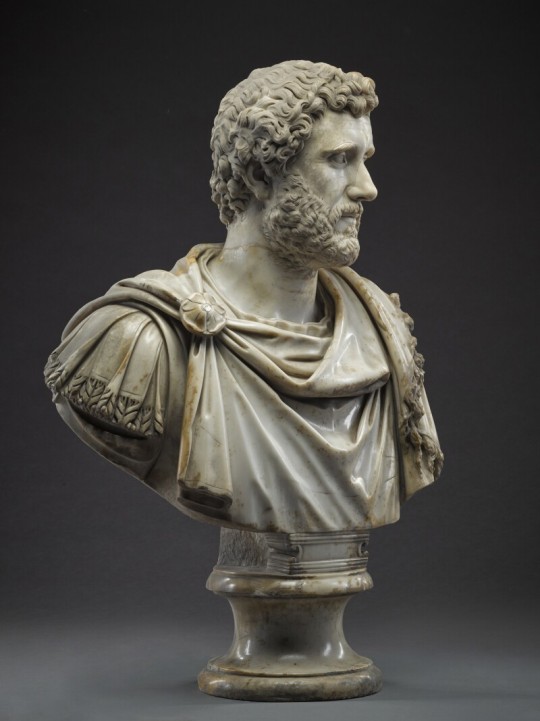

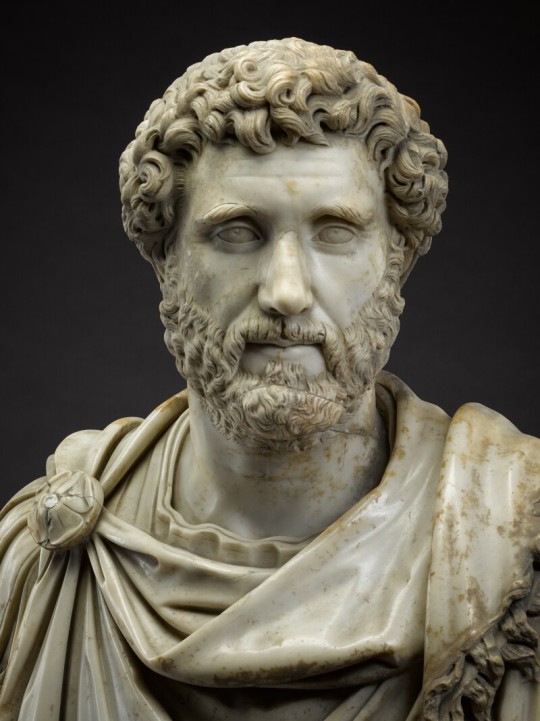
A Roman Marble Portrait Bust of Emperor Antoninus Pius
circa A.D. 140
Monumental in size, the emperor with his head turned to his left, his mature face with thoughtful countenance, full beard and moustache, deep-set eyes with incised irises and dotted pupils, and incised eyebrows, his thick hair radiating from the crown in long wavy locks and massed in rich deeply drilled and unruly voluted curls around the forehead and temples, and wearing a tunic, cuirass, and paludamentum fastened with a circular brooch on the right shoulder, the fringed hem of the cloak falling in zigzag folds from the left shoulder, the entire bust and its socle carved in one piece.
Height 97 cm.
Antoninus Pius (19 September 86 – 7 March 161) was Roman emperor from 138 to 161. He was the fourth of the Five Good Emperors from the Nerva–Antonine dynasty.
Born into a senatorial family, Antoninus held various offices during the reign of Emperor Hadrian. He married Hadrian's niece Faustina, and Hadrian adopted him as his son and successor shortly before his death. Antoninus acquired the cognomen Pius after his accession to the throne, either because he compelled the Senate to deify his adoptive father, or because he had saved senators sentenced to death by Hadrian in his later years. His reign is notable for the peaceful state of the Empire, with no major revolts or military incursions during this time. A successful military campaign in southern Scotland early in his reign resulted in the construction of the Antonine Wall.
Antoninus was an effective administrator, leaving his successors a large surplus in the treasury, expanding free access to drinking water throughout the Empire, encouraging legal conformity, and facilitating the enfranchisement of freed slaves. He died of illness in 161 and was succeeded by his adopted sons Marcus Aurelius and Lucius Verus as co-emperors.
#A Roman Marble Portrait Bust of Emperor Antoninus Pius A.D. 140#Emperor Antoninus Pius#marble#marble bust#marble statue#history#history news#ancient history#ancient culture#ancient civilizations#ancient rome#roman empire#roman emperor#roman history#roman art
127 notes
·
View notes
Photo
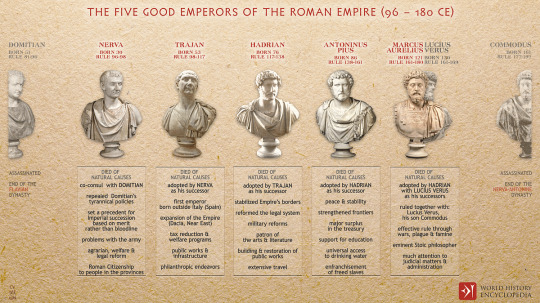
The Five Good Emperors of the Roman Empire (96 - 180 CE)
An infographic illustrating the succession of Roman rulers between 96 and 180 CE, known as the Five Good Emperors (a term unknown to the ancient Romans, coined by Nicolo Machiavelli in his 1531 manuscript Discourses on Livy and made widely popular by Edward Gibbon in his 18th century The History of the Decline and Fall of the Roman Empire,) Nerva, Trajan, Hadrian, Antoninus Pius, and Marcus Aurelius. Those were everyone but two of the Nerva-Antonine Dynasty, with Lucius Verus and Commodus not making the cut. During the time of this “kingdom of gold” (Gibbon), the Roman Empire “was governed by absolute power under the guidance of wisdom and virtue.” (Gibbon) The 84-year period is widely accepted as the high point of the Empire, with Imperial Succession ensured through adoption based on merit and acceptance rather than a strict bloodline.
Image by Simeon Netchev
81 notes
·
View notes
Text
In a first, coin bearing zodiac found off Israel's coast
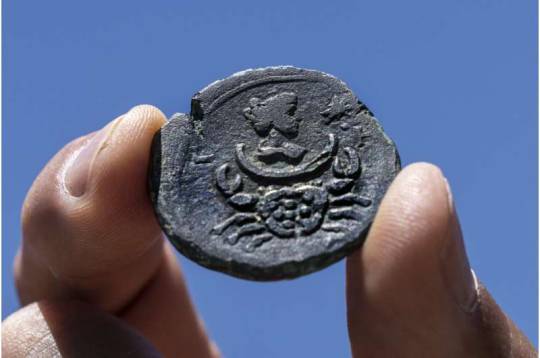
Israel's Antiquities Authority said Monday it has discovered a rare 1,850-year-old bronze zodiac coin during an underwater survey off the coastal city of Haifa.
The coin bears the image of the zodiac sign Cancer behind a depiction of the moon goddess Luna.
Experts say the coin was minted in Alexandria, Egypt, under the rule of the Roman Emperor Antoninus Pius, who ruled between the years 138–161 A.D. It is part of a series of 13 coins depicting the 12 zodiac signs and one of the entire zodiac wheel.
The antiquities authority said it was the first time such a coin has been found off the Israeli coast. Read more.
839 notes
·
View notes
Text

Gold seal ring bearing the name of the Roman emperor Antoninus Pius translated into Egyptian hieroglyphs.
📷 : hellenistichistory
209 notes
·
View notes
Text
One of the coolest artifacts at the Carnegie Science Center's Titanic exhibition was an ancient Roman gold coin from the reign of Emperor Antoninus Pius (reign 138 - 161 AD). The coin was made into a pendant necklace and eventually became a keepsake of one of the passengers of the RMS Titanic, then was later salvaged from the shipwreck.

131 notes
·
View notes
Text

The Temple of Apollo is a Roman temple built around 150 A.D. during the Pax Romana era in the ancient Pamphylian town of Side, in southern Turkey on the Mediterranean Sea coast and dedicated to Apollo, the Greek and Roman god of music, harmony and light.
The Temple of Apollo dates back to the time of Roman emperor Antoninus Pius (138-161 A.D.). Between 1984 and 1990, the five columns, which remained standing side by side over centuries, and the capitals were restored. As the concrete base carrying the columns started to wear down, and the iron bars inside the columns came to the surface effected by weather conditions, restoration works were carried out in 2017.
The broken parts of the columns were repaired with same material used during the restoration in the 1980s. The Templae of Apollo is a notable tourist attraction in Antalya Province.
39 notes
·
View notes
Photo

A Roman Marble Portrait Bust of Emperor Antoninus Pius. circa A.D. 140. Sotheby’s Dec. 2022. http://hadrian6.tumblr.com
161 notes
·
View notes